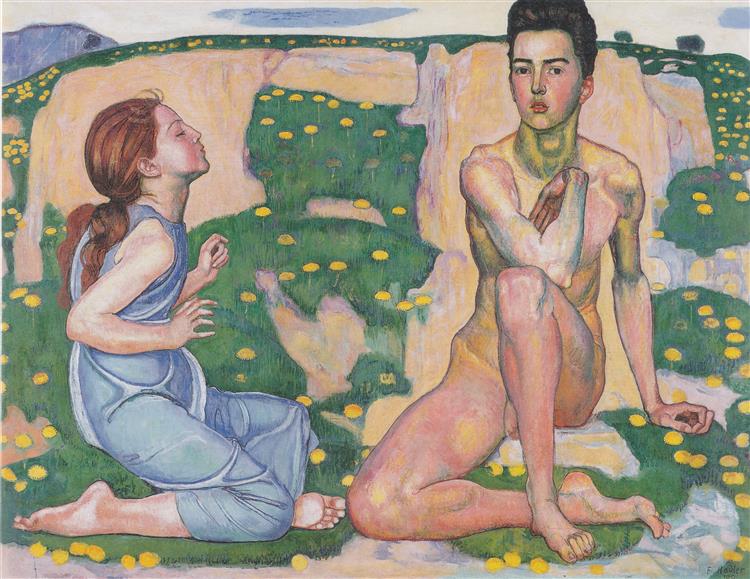Description
The painting "El Frühling" (also known as "Der Frühling"), created by Ferdinand Hodler in 1901, is a masterpiece that encapsulates the essence of symbolism and stands out for its enigmatic beauty and meticulous composition. Observing the work, we are facing a stage full of meaning and emotion, in which the Swiss artist displays all his talent to convey an idealized and almost magical vision of spring.
The first thing that attracts attention in "The Frühling" is the arrangement of the characters, five female figures in total, organized so that they seem to dance in perfect harmony with the surrounding environment. These figures, with their slender bodies and delicate gestures, seem to symbolize the different stages or aspects of the spring awakening, a rebirth that manifests both in nature and in the human spirit.
As for the artistic composition, Hodler uses an almost symmetrical disposition to accentuate serenity and natural order. The female figures are aligned in a kind of classic frieze, a disposition that gives the scene a timeless and ceremonial character. The repetition of forms and the upright position of the characters reinforce the idea of a cyclical and immutable rite, evoking the eternal renewal of spring.
The use of color in "Frühling" is particularly notable. Hodler resorts to a palette of soft tones and cakes that invoke the freshness and lightness of this season. The predominance of green, blue and roses creates an atmosphere of tranquility and hope, while touches of white, especially in women's clothes, suggest purity and a new beginning. The light blue sky and the emerald green field in the background reinforce this feeling of fullness and resurgence.
There is a subtle symbolism in painting that attributes an almost mystical character to the work. The female figures could be interpreted as nymphs or personifications of the natural forces, merging with the environment in a way that underlines the unity between the human being and nature. The Swiss artist, known for his inclination towards symbolism, achieves in this work a perfect balance between realistic and allegorical representation.
You can't talk about "Frühling" without mentioning Hodler's impeccable technique. The delicacy in the strokes and the precision in the anatomical details demonstrate their mastery in the drawing and his deep knowledge of the human body. Each figure is treated with such care that you can almost feel their movement and breathing, which gives the work a unique vitality.
It is important to place this work in the context of Ferdinand Hodler's career. Born in 1853 in Bern, Switzerland, Hodler became one of the most important figures of the Swiss art of the nineteenth and early twentieth century. His work covered a broad spectrum of styles, from realism to symbolism, always reflecting an incessant search for beauty and truth. "Frühling" is a piece that, although less known compared to other of his works, encapsulates his ability to combine a refined technique with a deep emotional and symbolic load.
"Frühling" by Ferdinand Hodler is undoubtedly a celebration of life and nature in all its splendor. It is a work that invites contemplation and reflection on the intrinsic relationship between human being and the natural world. Hodler, with his visionary gaze and his masterful technique, gives us a scene that transcends time and space, resonating with a beauty as fresh and renovating as spring itself.
KUADROS ©, a famous paint on your wall.
Hand-made oil painting reproductions, with the quality of professional artists and the distinctive seal of KUADROS ©.
Art reproduction service with satisfaction guarantee. If you are not completely satisfied with the replica of your painting, we refund your money 100%.

